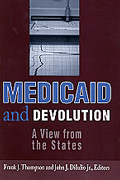Studies in this week’s Hutchins Roundup find that global factors are behind persistently low inflation, that Medicaid reduces mortality for 55- to 64-year-olds, and that business sector labor share declined in the US, but not globally.
Want to receive the Hutchins Roundup as an email? Sign up here to get it in your inbox every Thursday.
Global factors beyond monetary policy are behind persistently low inflation
The unemployment rates in the United States, the United Kingdom and Germany are now all below 4%, lower than they’ve been in decades, yet inflation remains subdued in all three countries. Some researchers, therefore, argue that the Phillips curve, the basic relationship between inflation and unemployment, is no longer a useful descriptor of inflation dynamics. Òscar Jordà, Chitra Marti, Fernanda Nechio, and Eric Tallman of the Federal Reserve Bank of San Francisco argue that, since the financial crisis, fluctuations in labor market conditions in developed economies have been largely offset with appropriate interest rate changes by central banks, keeping inflation low and masking the underlying Phillips curve relationship. However, inflation has also been falling in developing countries, where central banks are often constrained and cannot fully offset changes in unemployment, suggesting that good monetary policy is not the only reason for current low global inflation. The authors suggest that increasing trade openness, global supply chains, and greater capital and investment flows across countries began reducing costs of production and investment, putting downward pressure on prices around the globe even before the financial crisis.
Medicaid reduces mortality for 55- to 64-year-olds
In 2014, 29 states opted to expand Medicaid eligibility to families with incomes below 138% of the federal poverty level under the Affordable Care Act (ACA). Sarah Miller of the University of Michigan and coauthors use data from the American Community Survey linked to administrative death records to examine whether the Medicaid expansion improved the health of its beneficiaries. Comparing the mortality rates across expansion and non-expansion states of near-elderly adults likely to benefit from the Medicaid expansion (based on income, citizenship, and public program participation), the authors find that having Medicaid reduced annual mortality by 0.13 percentage point, or about 9%. With approximately 3 million 55- to 64-year-olds living in non-expansion states, the authors calculate that the failure to expand Medicaid in these states resulted in 15,600 additional deaths over the four-year period from 2014 to 2017.
Business sector labor share declined in the United States, but not globally
Economists, policymakers, and the public have been concerned about the global decline in the labor share, the share of value-added going to wages and benefits. Germán Gutiérrez of New York University and Sophie Piton of the Bank of England revisit the evidence for the declining labor share and find that it largely reflects measurement error. For major countries other than the United States, the labor share from the corporate sector has actually been relatively stable since the 1980s once housing is excluded and self-employment is properly accounted for, they say. For the U.S., the corporate labor share has declined, particularly in manufacturing. The uniqueness of U.S. trends and the critical role of manufacturing cast doubt on most technological explanations for the decline of the U.S. labor share, they conclude, since such explanations would likely affect all countries and industries.
Chart of the week: Death rates are rising for young and middle-aged US adults

Quote of the week:
“I would say based on what we’ve seen since the middle of June, the data has gotten somewhat stronger, not somewhat weaker. I do think that there is a more positive twist in how the data’s come in to date. I would also say that I do worry that it’s not costless to be pre-emptive, and the reason it’s not costless is I do worry about financial stability concerns. The stock market is at or close to all-time highs. The amount of corporate leverage that we have is also quite high,” says Eric Rosengren, president of the Federal Reserve Bank of Boston.
“So reducing interest rates at this stage of the financial cycle won’t be costless if it encourages a risk-on behavior that actually makes an eventual pullback sometime in the future even more costly. We certainly do have to think about the zero lower bound. We certainly have to think about whether the economy is significantly weakening at this stage. And then we have to think about what the offset in costs would be to financial stability if we decide to be more accommodated.”












Commentary
Hutchins Roundup: Low global inflation, Medicaid’s Effects on Mortality, and more
July 25, 2019
Studies in this week’s Hutchins Roundup find that global factors are behind persistently low inflation, that Medicaid reduces mortality for 55- to 64-year-olds, and that business sector labor share declined in the US, but not globally.